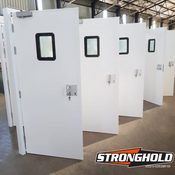top of page
FREQUENTLY ASKED QUESTIONS
Frequently Asked Questions | Stronghold
Transformer Doors
Fire Doors
Storage Of Fire Doors
What if a Fire Door becomes wet?
Anti-Ligature Doors vs Seclusion Room Doors
You can use the following cleaning solutions:
Mild Detergent: Warm water mixed with mild dish detergent works well for removing dirt and grease.
Acetone: An effective solvent for removing oils; be sure to use it in a well-ventilated area.
Denatured Alcohol: Great for degreasing, it evaporates quickly after cleaning.
Commercial Metal Cleaners: Look for products designed specifically for galvanised surfaces, which may contain phosphoric acid.
TSP (Trisodium Phosphate): A heavy-duty cleaner for stubborn grime, but ensure you rinse thoroughly afterward.

























bottom of page
